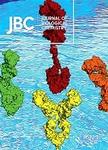版权所有:内蒙古大学图书馆 技术提供:维普资讯• 智图
内蒙古自治区呼和浩特市赛罕区大学西街235号 邮编: 010021

作者机构:DepartmentofMedicineHowardHughesMedicalInstituteUniversityofVirginiaCharlottesvilleVirginia22908USA.
出 版 物:《JOURNAL OF BIOLOGICAL CHEMISTRY》 (生物化学杂志)
年 卷 期:1999年第274卷第48期
页 面:34506-34506页
核心收录:
学科分类:0710[理学-生物学] 071010[理学-生物化学与分子生物学] 081704[工学-应用化学] 07[理学] 08[工学] 0817[工学-化学工程与技术]
基 金:National Institute of Diabetes and Digestive and Kidney Diseases, NIDDK, (R01DK041077) National Institute of Diabetes and Digestive and Kidney Diseases, NIDDK
主 题:氨基酸序列 钙-钙调素依赖性蛋白激酶类/代谢 催化域 细胞 培养的 仓鼠亚科 酶激活 表皮生长因子/药理学 胰岛素/药理学 分子序列数据 突变 磷酰化 蛋白质结构 二级 核糖体蛋白质S6激酶类/化学 核糖体蛋白质S6激酶类/遗传学 核糖体蛋白质S6激酶类/代谢 核糖体/酶学 序列缺失 序列同源性 氨基酸 信号传导 动物
摘 要:p90 ribosomal S6 kinases (RSKs), containing two distinct kinase catalytic domains, are phosphorylated and activated by extracellular signal-regulated kinase (ERK). The amino-terminal kinase domain (NTD) of RSK phosphorylates exogenous substrates, whereas the carboxyl-terminal kinase domain (CTD) autophosphorylates Ser-386. A conserved putative autoinhibitory alpha helix is present in the carboxyl-terminal tail of the RSK isozymes (^697HLVKGAMAATYSALNR^712 of RSK2). Here, we demonstrate that truncation (Δα) or mutation (Y707A) of this helix in RSK2 resulted in constitutive activation of the CTD. In vivo, both mutants enhanced basal Ser-386 autophosphorylation by the CTD above that of wild type (WT). The enhanced Ser-386 autophosphorylation was attributed to disinhibition of the CTD because a CTD dead mutation (K451A) eliminated Ser-386 autophosphorylation even in conjunction with Δα and Y707A. Constitutive activity of the CTD appears to enhance NTD activity even in the absence of ERK phosphorylation because basal phosphorylation of S6 peptide by Δα and Y707A was ~4-fold above that of WT. A RSK phosphorylation motif antibody detected a 140-kDa protein (pp140) that was phosphorylated upon epidermal growth factor or insulin treatment. Ectopic expression of Δα or Y707A resulted in increased basal phosphorylation of pp140 compared with that of WT, presenting the possibility that pp140 is a novel RSK substrate. Thus, it is clear that the CTD regulates NTD activity in vivo as well as in vitro.